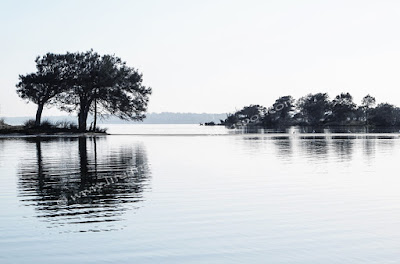My front garden is lovely in summer. Especially during the months of December and January it is ablaze with colour - the red of the coral bush, the yellow of the kangaroo paws, yellow daisies and day lillies, the purple and blue of the native hibiscus and agapanthus, and the pink of the hydrangea. Plus the various colours of the roses.
I know I have shared some of these delights before with you - Summer in my garden
And I am sure you remember the tinsel I draped around my kangaroo paws in a miserable attempt to keep the parrots from devouring them!
But strangely this year we haven't had the parrots visit our yard in the numbers we usually have, so the kangaroo paws have been safe from them.
Most mornings during January we have sat in the cool shade of our front verandah for morning tea. It is a lovely place to sit looking over the garden.
Just off the edge of the verandah is a stand of tall green kangaroo paws. From my research I am guessing these are Anigozanthos flavidus.
The kangaroo paw derives its name from its flowers, which feel furry, and are shaped just like a kangaroo's paw. They are native to Western Australia.
These green kangaroo paws were in are garden when we arrived, and have thrived every since.
Anigozanthos is endemic to Western Australia,
where there are 11 species and 13 recognised sub-species. All are
recognisable by their distinctive inflorescences (flower-heads) and are
found through-out the south-west from Kalbarri to east of Esperance.
They have been known as ‘Kangaroo Paws’ since the 1850s – but were
originally called a ‘Kangaroo Foot’. Smaller species are now referred to as ‘catspaws’. Anigozanthus is closely
related to the genus Macropidia (the’ Black Kangaroo Paw’), which now
has its own monotypic genus.
Wildflower Society of WA - Paws for thought
Can you see the little open flower heads? I can guarantee you that the nectar feeding birds have, and that is exactly what the kangaroo paws want.
Key
nectar-feeding birds pollinating the kangaroo paw are the brown honeyeater, red
wattlebird, western spinebill and white-cheeked honeyeater.
 The nectar of the kangaroo paws is found in
the long and tubular flowers and is an important high-energy food source for many
birds, mammals and insects.
The
long flower-stalks usually rise above the undergrowth and 'advertise' the
presence of nectar in the flowers. The stalks also provide a perch for visiting
birds.
The nectar of the kangaroo paws is found in
the long and tubular flowers and is an important high-energy food source for many
birds, mammals and insects.
The
long flower-stalks usually rise above the undergrowth and 'advertise' the
presence of nectar in the flowers. The stalks also provide a perch for visiting
birds.
The shape
of the flowers and the position of the pollen-bearing anthers is a feature
which allows pollen to be deposited on the head of feeding birds. This pollen
is transferred from flower to flower as the birds feed. Different species
usually deposit pollen on different areas of the birds' head. This means that
pollen from one species is unlikely to be deposited in the flowers of another
species.
In the pictures below you can see the little brown honeyeater which visited our kangaroo paws every morning, flitting from plant to plant. It was delightful to sit and watch them while we had our morning tea. They seemed unconcerned about us.
I noticed that there seems to be only one "flower" open on each "paw" at a time. Perhaps they close up when the nectar has been drunk, and another one opens up, and that the red anthers signal to the birds. Although I can't find any information about this.
We also have a yellow kangaroo paw in our garden, so I found it interesting to read that because of the position of the pollen-bearing anthers depositing the pollen onto a different part of the birds head, it was unlikely to cross pollinate flowers of a different kangaroo paw species. Isn't nature amazing!
I must say thank you to my husband for the photos of the brown honeyeater.
 Below you can see the Mangles Kangaroo Paw - Anigozanthos manglesii - which is the floral emblem of Western Australia. About 1.25 metres tall, the red and green flowers are very striking.
Below you can see the Mangles Kangaroo Paw - Anigozanthos manglesii - which is the floral emblem of Western Australia. About 1.25 metres tall, the red and green flowers are very striking.
The birds have to bury their heads into the base of this flower to reach the nectar.
The
size, flower-stalk height and colour of kangaroo paws flowers varies between
the species. Many new forms have also arisen as the result of deliberate
hybridisation.
For more information on kangaroo paws you might like to visit:
Backyard Buddies
Australian National Botanic Gardens, Canberra
Scitech.org.au
Blue Planet Biomes
Australian National Herbarium - WA emblem
Thank
you so much for stopping by. I hope you have enjoyed this post about the kangaroo paw, which is just one of Western Australia's amazing native species which I feel so lucky to be able to photograph, and in this case to have in my garden attracting birds.
I value your comments and look forward to
hearing from you. I will try to visit your blogs in return. Have a
wonderful week.
I
am linking up to the link-ups below. Please click on the links to see
fabulous contributions from around the world - virtual touring at its
best!
Hello there! I love reading your comments. If you scroll down to the bottom you can comment too! I would love to hear from you.

































